 In early 2011, ElephantVoices launched a citizen science elephant conservation project in the Maasai Mara ecosystem, known as "Elephant Partners". Our goal was to develop a working model for citizens to monitor and protect elephants. This initiative was made possible through support from the generous organisations and inviduals listed at the bottom of this page.
In early 2011, ElephantVoices launched a citizen science elephant conservation project in the Maasai Mara ecosystem, known as "Elephant Partners". Our goal was to develop a working model for citizens to monitor and protect elephants. This initiative was made possible through support from the generous organisations and inviduals listed at the bottom of this page.
Our concept was to connect individual people - guides, scouts, researchers, photographers, tourists, people of the Maasai Mara and all those who care - with the lives of individual elephants. Through use of social and educational media, our intention was to develop a community sharing knowledge of the Mara elephants and working together to protect them.
We wrapped up our work in the Mara in mid 2016, ensuring that the conclusions of Elephant Partners were incorporated into national and county level spatial and development plans. The overarching results of our project can be found in the collaborative report: Mara ecosystem connectivity: Information on elephant population status and movements for spatial planning and conservation in Narok County (A click on the link will download low resolution version of report, size 3,8 mb).
Citizen Science in the Mara
We built a fully searchable online elephant ID database for storing information, photographs and identifying features of each elephant. We called it the Mara Elephant Who's Who and populated it with photographic records contributed by many people residing in or visiting the Maasai Mara. In August 2013 National Geographic and other media covered the launch of this useful resource for our ongoing and collaborative conservation effort. We also prepared and made available online slideshows presenting how to identify African savanna elephants.
 Citizen scientists uploaded their observations of elephants via the specially designed Mara EleApp Mara EleApp (for Android) to the online interface of a second database, known as the Mara Elephants Whereabouts. The app provided an efficient way for people to collect and upload observations to the the database whether on the spot, or, with lack of connection, when a network was available. The Mara Elephants Who's Who & Whereabout databases were both password-protected while the project was ongoing, to avoid any misuse of location data.
Citizen scientists uploaded their observations of elephants via the specially designed Mara EleApp Mara EleApp (for Android) to the online interface of a second database, known as the Mara Elephants Whereabouts. The app provided an efficient way for people to collect and upload observations to the the database whether on the spot, or, with lack of connection, when a network was available. The Mara Elephants Who's Who & Whereabout databases were both password-protected while the project was ongoing, to avoid any misuse of location data.
In the five years of the project we collectively identified and registered over 1,200 individual adult elephants; collected data on the size, location and composition of over 4,000 elephant groups; determined habitat use, key resources and migration routes used by individual elephants; and documented over 100 mortalities. We made these and other baseline data available to the public throughout the project and in the final report linked above. Furthermore, we focused attention on the conservancies to bolster their important work; the future of elephants and other landscape species in the Mara ecosystem depends upon their commercial success as well as the sustainable management of the Masai Mara National Reserve.
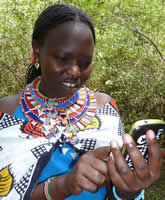 |
 |
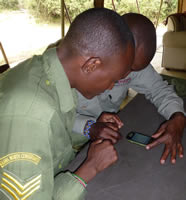 |
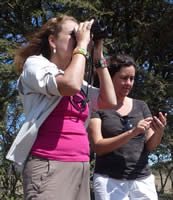 |
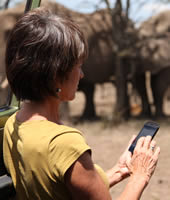 |
Elephants are important for the survival of the Mara
 As an iconic landscape species elephants are important to the survival of the Mara. They play a key role in the ecosystem and, through tourism, in the local economy. Their great size, sociality, intelligence and charisma make them important ambassadors for other threatened species. Many Mara elephants are killed each year and an even greater number are wounded by spears, arrows and snares.
As an iconic landscape species elephants are important to the survival of the Mara. They play a key role in the ecosystem and, through tourism, in the local economy. Their great size, sociality, intelligence and charisma make them important ambassadors for other threatened species. Many Mara elephants are killed each year and an even greater number are wounded by spears, arrows and snares.
Our work documented the very real threats facing the Mara elephants: rapid loss of habitat, rising human-elephant conflict, fencing and ivory poaching, and how elephants are responding to these challenges. The future of the Maasai Mara and its wildlife is at stake and elephants are central to the ecosystem's future.
Working together the only way forward
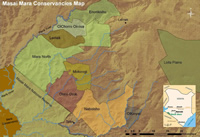 To achieve its vision ElephantVoices partnered with many entities and individuals: The many conservancies (Mara Triangle, Mara North, Lemek, Ol Chorro Oiroua, Enonkishu, Motorogi, Olare Orok, Mara Naboisho, Ol Kinyei, Olderikesi, see map), Kenya Wildlife Service, Maasai Mara National Reserve, members of the local community, the tourism sector and members of the general public, Mara Elephant Project, Elephant Aware, and the Koiyaki Guiding School were just a few of many important collaborators.
To achieve its vision ElephantVoices partnered with many entities and individuals: The many conservancies (Mara Triangle, Mara North, Lemek, Ol Chorro Oiroua, Enonkishu, Motorogi, Olare Orok, Mara Naboisho, Ol Kinyei, Olderikesi, see map), Kenya Wildlife Service, Maasai Mara National Reserve, members of the local community, the tourism sector and members of the general public, Mara Elephant Project, Elephant Aware, and the Koiyaki Guiding School were just a few of many important collaborators.
We are truly grateful for all input and help received during this initiative, and for numerous conversations about the situation in the Mara, the elephants and their movement patterns, the challenges, and more.
| The video is from a presentation of the Elephant Partners initiative by ElephantVoices' Joyce Poole, at National Geographic' Explorers Symposium in June 2012. |
| Thank you! We are grateful to those that through their monetary support made this project possible. |
|
| You'll find a list of in-kind supporters, collaborators and data contributors here - their interest and support were truly appreciated! |



